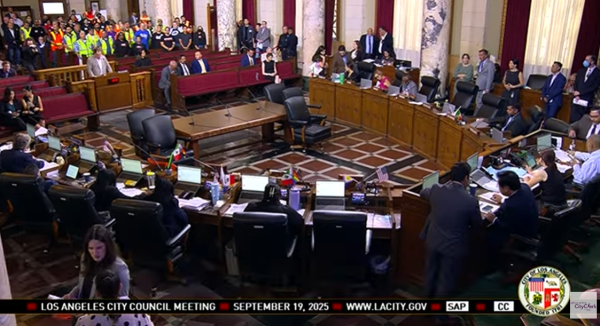Design and Construction Report staff writer
The Los Angeles City Council has approved a $2.6-billion expansion of the Convention Center, despite warnings about serious financial risks. Construction must begin immediately to meet the 2028 Olympic and Paralympic Games deadline, when the facility will host judo, wrestling, and other competitions.
Advisors told councilmembers that the project “a risky bet,” warning it could divert taxpayer funds from essential city services for decades. They also said any major construction delays would prevent the first phase from being completed in time for the 2028 Games.
However, construction workers and union representatives filled the council chamber last week, urging the council to approve the project and highlighting the local jobs it will create.
“I’m here to represent my fellow 150,000 skilled and trained union construction workers in 14 trades who shape Southern California,” said Ernesto Medrano, executive secretary of the Los Angeles and Orange County Building and Construction Trades Council. “It’s not just an investment in the convention center, it’s an investment in the careers and long-term success of our local workers and their families.”
The expansion is expected to create about 14,000 construction jobs with more than 8,000 local hires, and train over 1,600 new apprentices.
The contractor is a joint venture between AEG and Plenary Group. This public-private partnership is structured under a Design-Build-Finance-Operate-Maintain (DBFOM) model, with Populous serving as the project’s lead architect.
“These are real careers, not gigs,” Medrano said. “Our members are ready to don their hard hats, their work boots, their tool belts, and start moving dirt to build this convention center.”
Supporters say the project will transform downtown and spur future investment and redevelopment.
But opponents caution construction is too expensive amid a massive budget crisis and Controller Kenneth Mejia said it would not generate positive income for the city budget until the late 2050s.
“Due to the city’s consistent budgetary and financial problems with no real solutions for long-term fiscal health, our office cannot recommend going forward with the current plan at this time,” he said.
The project cost has been adjusted downward and is now expected to be about $89 million annually over 30 years, including at least $100 million annually from the city’s general fund.
The expansion will add roughly 325,000 square feet, connecting the South Hall’s curving green exterior with the West Hall, which is now faded blue. A new wing will be built over Pico Boulevard, a task Szabo described as “extraordinarily complicated and extraordinarily costly.”
With approval in place, crews are scheduled to begin demolition next month.

